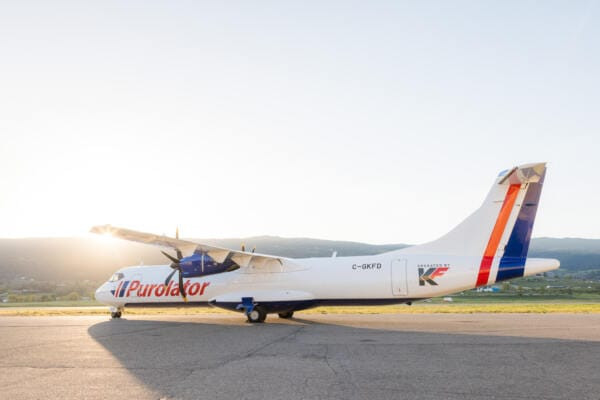- KF Aerospace acquires third ATR 72-500F to modernise Purolator’s British Columbia Feeder Network under a renewed 10-year contract.
- Fleet renewal replaces legacy Convair 580 aircraft, improving efficiency, compliance, and sustainability across regional cargo routes.
- In-house MRO conversions at Kelowna (YLW) include Large Cargo Door (LCD) installation, ADS-B upgrades, and dual FMS systems.
- All three ATR 72-500Fs to be operational by 2026, reinforcing connectivity for e-commerce, healthcare, and perishables across Western Canada.
- Policy implications extend beyond logistics: sustainability alignment with Canada’s 2030 Emissions Reduction Plan, regional connectivity as trade infrastructure, and domestic MRO integration for industrial resilience.
Canada’s regional air cargo market is entering a decisive phase of modernisation, with KF Aerospace acquiring its third ATR 72-500 freighter as part of a renewed ten-year contract to operate Purolator’s British Columbia Feeder Network (BCFN). The investment highlights a wider trend across secondary markets: replacing ageing turboprops with fuel-efficient regional freighters that align with sustainability goals, regulatory compliance, and growing e-commerce demand.
For policymakers and industry observers, the move reflects not only a commercial fleet decision but also a structural shift in how regional aviation underpins national trade resilience, connectivity, and climate commitments.
Fleet renewal and policy significance
The replacement of Purolator’s long-serving Convair 580 fleet with ATR 72-500Fs marks a turning point in regional air cargo strategy. The Convair 580, a platform with origins in the 1950s, has long been the backbone of feeder operations across Canada. Yet the aircraft’s rising maintenance costs, fuel inefficiency, and noise and emissions profile place it increasingly at odds with Canada’s climate policy and ICAO’s CORSIA requirements.
By contrast, the ATR 72-500F offers containerised loading and up to 40% lower fuel burn than legacy turboprops. ATR data suggests the aircraft typically consumes around 1,200 kg of fuel per block hour, compared with nearly 1,900 kg for older types such as the Convair. These gains translate directly into lower carbon intensity and improved cost efficiency—two factors central to modern air cargo competitiveness.
The transition supports Canada’s 2030 Emissions Reduction Plan, which targets a 40–45% reduction in greenhouse gas emissions from 2005 levels. With regional feeders operating at high frequency, even incremental efficiency gains contribute significantly to national climate goals.
Regional connectivity as trade infrastructure
Purolator’s BCFN forms a critical artery in Western Canada’s logistics chain, linking smaller communities to distribution hubs in Vancouver and beyond. These feeder services handle a significant share of time-sensitive cargo, from healthcare shipments and perishables to the surging volumes of e-commerce.
According to Statistics Canada, e-commerce accounted for 10.9% of total retail sales in 2024, up from 6.9% in 2019, reflecting a structural shift in consumer behaviour. Canada Post and Purolator together handle more than one billion parcels annually, and regional air cargo ensures that smaller communities remain connected to national and international trade flows.
Fleet modernisation in this context is not only about operational efficiency; it is also a policy lever for economic inclusion. By sustaining reliable access to logistics networks, regional aviation contributes directly to the competitiveness of Canada’s small businesses and exporters.
As Tracy Medve, CEO of KF Capital Ltd, noted: “The acquisition of this third aircraft represents a continued investment in the modernisation of our air cargo fleet. As part of our fleet upgrade strategy for our long-standing partnership with Purolator, this aircraft further supports our commitment to delivering safe, efficient, and reliable service for Purolator’s BC Feeder Network.”
Technical upgrades and domestic MRO integration
The latest ATR 72-500 (MSN 685), acquired from FlyCAA, will undergo a Large Cargo Door (LCD) conversion at KF Aerospace’s Kelowna (YLW) facility. The modification programme includes upgrades mandated under Supplemental Type Certificates (STCs), such as ADS-B compliance and dual Flight Management Systems (FMS), ensuring operational alignment across the fleet.
One ATR has already completed conversion and entered revenue service, while a second aircraft, sourced from ACIA Aero Leasing, is being prepared for bulk-loading operations. All three ATRs are expected to be fully operational by 2026.
By carrying out the LCD conversion in-house, KF Aerospace is reinforcing domestic MRO capability—an often overlooked but strategically significant element of aviation policy. Localising maintenance not only shortens turnaround times and reduces reliance on overseas facilities but also builds technical employment capacity within Canada. The expansion is expected to generate new skilled jobs in British Columbia, aligning with national industrial policy goals around workforce development in aerospace.
Market implications: From obsolescence to modernisation
Across North America, approximately 250 feeder aircraft still rely on legacy turboprops such as the Convair 580, Saab 340, and early-generation Dash 8. Many of these platforms face obsolescence by the end of the decade as regulatory compliance costs rise and parts availability declines.
The shift to ATR freighters is therefore part of a wider market pattern shaped by three core pressures:
- Sustainability compliance: fleet renewal contributes to ICAO’s global offsetting schemes and national net-zero targets.
- Digitalisation: ADS-B and dual FMS systems align with North American air traffic management standards, improving safety and interoperability.
- E-commerce demand: Deloitte projects Canadian e-commerce volumes to grow at an annual rate of 11% through 2030, placing increasing reliance on regional cargo networks.
For cargo operators, modern turboprops offer a way to reconcile rising demand with cost and regulatory pressures. For policymakers, they provide a template for balancing regional connectivity with sustainability objectives.
Policy takeaways
- Fleet Modernisation as a Policy Lever
Regional fleet renewal supports climate targets while sustaining logistics efficiency. Governments may consider incentives to accelerate transitions across North America’s feeder networks.
- Regional Connectivity as Trade Infrastructure
Feeder services underpin not just logistics but also economic inclusion, linking remote communities to national and global markets. Policy frameworks should recognise regional cargo as strategic trade infrastructure.
- Domestic MRO Integration
KF Aerospace’s in-house conversions highlight how MRO capability can align with industrial policy, securing skilled employment and reducing supply chain reliance on offshore facilities.
- Sustainability Alignment
Replacing legacy aircraft with ATR 72-500Fs reduces fuel burn and emissions intensity, supporting Canada’s CORSIA compliance and national climate plans.
- E-Commerce and Policy Coordination
With parcel volumes rising, regulators and industry must ensure that regional networks have the infrastructure capacity to handle sustained double-digit growth.
Outlook
KF Aerospace’s acquisition of a third ATR 72-500F goes beyond a single contract renewal with Purolator. It illustrates how regional cargo operators are aligning commercial decisions with broader sustainability, trade, and industrial policy objectives.
By modernising its fleet, KF not only secures the reliability of Western Canada’s feeder network but also provides a model for how secondary markets can adapt to evolving environmental regulation and market demand. The integration of domestic MRO capacity further strengthens Canada’s industrial resilience, while the alignment with national climate policy positions regional aviation as a partner in meeting broader sustainability targets.
As the aircraft enter service by 2026, the BCFN upgrade will be closely watched by policymakers and industry stakeholders alike. For the air cargo sector, it represents a practical example of how technology, regulation, and trade flows intersect—illustrating that the modernisation of regional fleets is as much about policy as it is about aircraft.





